Well, the nightmare that was the Atlanta Braves’ 2014 season has ended. The Braves finished the season with a 79-83, finishing below .500 for only the 4th time since 1990. Their swoon was capped by a 7-18 September that ended the remote shot they had at a Wild Card spot.
The disappointing result has led to a shakeup in the Braves’ front office. While manager Fredi Gonzalez will return to manage in 2015, General Manager Frank Wren was fired. Assistant GM Bruce Manno was also fired. The scouting department has been largely revamped, with Director of Scouting Tony DeMacio being reassigned, and former scouting director Roy Clark returning to the position he once held. Hitting coach Greg Walker, assistant Scott Fletcher, and third base coach Doug Dascenzo were all let go. Special Advisor John Hart has been named the interim GM, and the general feeling is that he will hold the position for a year or two to groom Assistant GM John Coppolella for the position.
While there is plenty of blame to go around, ultimately, the players’ on-field performances determine whether a team is likely to be successful in any given season. By most any measure, every Braves position player, save perhaps Justin Upton and Evan Gattis, saw their 2014 performance lag behind their 2013 performance (which was a frustrating year offensively, as well).
So how did the Braves’ players do? We begin by grading the position players.
Catcher: C

Evan Gattis (Grade: A-) increased his performance across the board in 2014, posting a higher OPS (.810), wOBA (.352), and wRC+ (125). He also managed to increase his defensive value slightly, although some of that appears to be due to him not playing LF this year. His 2014 K-rate (24.2%) increased slightly over his 2013 rate (21.2%), while his BB rate remained steady at 5.5%. Really, the only negative that can be said about Gattis is that he missed a lot of games. Clearly Fredi Gonzalez was resting him regularly to keep him fresh and to reduce some of the stress on his knees, since he had two off-season knee procedures prior to the season. But just as Jason Heyward was struck with odd, unpredictable ailments last season, so did Gattis suffer from some rather crazy incidents. He missed 7 days with two different viral illnesses early in the year, and then missed almost 10 days with a strep infection late in the year, which ultimately dehydrated him so much that it caused a kidney stone attack. More concerning, however, is the 22 games missed due to a bulging disk in his back. Gattis has had multiple issues with his back and with the oblique muscle in the past. His violent, vicious swing creates tremendous amounts of torque, making him a prime candidate for continued problems with those injuries. Had Gattis not disappeared (literally) for the last month, we may have been able to roll into the Wild Card and lose it.
Gerald Laird (Grade: D) was very serviceable in a part-time role in 2013, but this year, he was pretty bad. He posted a wRC+ of 49 this season, compared to a very respectable 112 last year.
Christian Bethancourt (Grade: D) saw some extended playing time in a couple of Gattis’ absences. As expected, his offense was anemic, posting a .548 OPS and 54 wRC+. Surprisingly, the rookie heralded for his defense had more passed balls (6) than Gattis (5) this year, in 530 fewer innings. Those passed balls seem to be a case of laziness, as his rate of wild pitches was much lower than Gattis. If Bethancourt is the catcher of the future in Atlanta, there needs to be some Ruthian-level return in any off-season trades.
First Base: A
Freddie Freeman (Grade: A) followed up his MVP level 2013 season with essentially the same type of season in 2014. The primary difference between the two years is luck and slightly less power. In 2013, Freeman had an unusually high BABIP (.371) for the season as a whole, and an insane .505 BABIP with runners in scoring position, which yielded a .443 average w/ RISP, and led to him driving in 21.7% of all runners on base when he was at the plate. This year, his BABIP was a more modest .351, which translated to a .294 average w/ RISP and 14.7% of runners on base driven in. Some of those line drives started finding gloves this year, but that doesn’t mean Freeman didn’t have a good year. His K-rate ticked up very slightly (19.2% to 20.5%), but his walk rate increased (10.5% to 12.7%). His power dropped slightly (.173 ISO down from .181), but nothing more than random variation from year to year. With a 140 wRC+, Freeman was second only to Anthony Rizzo among NL first basemen. He also played in every game this season; one has to wonder if the wear and tear caught up with him later in the year.
Second Base: D
Dan Uggla (Grade: F) was released just before the All-Star break because he forgot how to hit. Oh, he could still swing a bat–he just couldn’t hit anything with it. There are two amazingly incongruous things about Dan Uggla from 2013 to 2014: his batting average dropped from .179 to .162, and his K-rate fell from 31.8% to 27.6%. Somehow, he managed to cut his strikeout rate by 15% and still watch his already horrible average plummet. He also lost all semblance of power and stopped drawing walks. Since he was only capable of playing one position, he was effectively a waste of a roster spot. As bad as he was, he wasn’t the worst second baseman in baseball by either WAR (Skip Schumaker) or wRC+ (Ryan Goins). So, he had that going for him…which is nice.
Tommy La Stella (Grade: C-) was called up as the initial replacement for Uggla, and he did a largely decent job for a while. La Stella is a high contact, low strikeout guy who takes walks–exactly what many fans were demanding. But he has little power, and his meager SLG (.317) meant that the hits he did provide often went wasted. However, one area where La Stella did excel was driving in runs. He led the team in driving in the runners that were on base in his plate appearances (15.5%), just edging out Justin Upton (15.4%). Over half of the runs he drove in were on third base at the time, and a single there is just as good as an extra base hit. La Stella is probably not a long-term solution at second base, but he is viable enough to serve as a stopgap. And, he isn’t Uggla.
Step on up, Phil Gosselin (Grade: C+)! You’re this year’s winner of the Jose Costanza Fan Favorite For No Reason Award! Gosselin was called up because he was tearing the cover off the ball at AAA, hitting .344 (driven by an insanely unsustainable .401 BABIP). Not bad for a career .266 hitter who had never shown power. But, it was enough to get him called up, and he eventually replaced La Stella as the primary second baseman when his luck followed him up the line. Gosselin is a low walk, slightly high strikeout, average contact guy with average speed….there was no reason for his BABIP to hold, and sure enough, in late August, those batted balls started finding gloves. He was also very poor at driving in runs (3.5%), with only Harang and Santana driving in runners on base at a lower rate. Gosselin can play multiple positions and he is a functional bench piece. He may even be good enough defensively to platoon with La Stella until Jose Peraza is ready. Gosselin was the only Braves second baseman with a positive WAR, driven primarily by his defense. And, he isn’t Uggla.
Shortstop: C
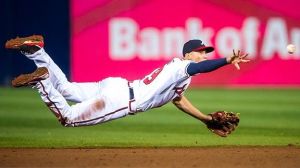
Andrelton Simmons (Grade: C) was the best defensive player in baseball again. He wasn’t quite as good as he was in 2013, but, similar to what we’ve seen with Craig Kimbrel, a guy can’t be the best ever in history every year. But as good as he was with the glove, he was equally awful with the bat. In fact, Simmons was the worst regular Braves’ player offensively this year–even worse than B.J. Upton (71 wRC+ to 74 for Upton). While his average and OBP were similar to last year, his power disappeared. His contact rate remained level, and he still had a below average strikeout rate, which just goes to show that contact and not striking out–absent other skills–are not necessarily in and of themselves a good thing. He had the highest contact rate and the lowest strikeout rate on the team, and he was its worst hitter.
Third Base: C
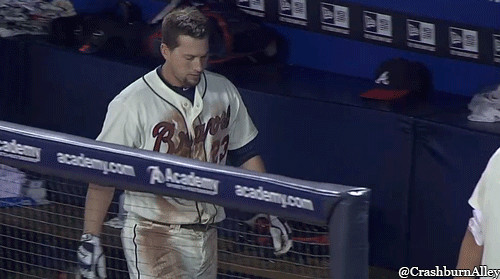 I tried to tell folks that Chris Johnson (Grade: D) was not as good as they thought, and that he was the beneficiary of some very favorable random variance. Chris Johnson hit .321 last season, but did so on the back of a .394 BABIP. This year, with a lower (and yet still fairly inflated) BABIP of .345, he managed to hit .263. He’s a guy who needs a very high BABIP to be mediocre, and he needs an exceptionally high BABIP to be considered good. He has no real power, he strikes out a lot, he rarely walks, he hits into a ton of double plays, he’s not a good baserunner, he’s slow, and he’s not a good defender. And he may be psychologically unhinged. Other than that, he could have some value.
I tried to tell folks that Chris Johnson (Grade: D) was not as good as they thought, and that he was the beneficiary of some very favorable random variance. Chris Johnson hit .321 last season, but did so on the back of a .394 BABIP. This year, with a lower (and yet still fairly inflated) BABIP of .345, he managed to hit .263. He’s a guy who needs a very high BABIP to be mediocre, and he needs an exceptionally high BABIP to be considered good. He has no real power, he strikes out a lot, he rarely walks, he hits into a ton of double plays, he’s not a good baserunner, he’s slow, and he’s not a good defender. And he may be psychologically unhinged. Other than that, he could have some value.
Outfield: B-
Justin Upton (Grade: A) was far more consistent this year, up until the combined team vacation in September. On the surface, it seems to be a relative carbon copy of last year, with many of his numbers virtually the same as last year. One difference was a slight uptick in his ISO. His Hr/FB rate remained exactly the same (17.9%), but he hit significantly more fly balls this year, with corresponding drops in his line drives and ground balls. His increased RBI total was a function of having more opportunities than last year (474 runners on base this year vs 304 last season). While he had a very good overall season, his September swoon was particularly untimely, since Upton is the type of guy who can carry a team when he’s on.
Jason Heyward (Grade A-) started off the season in typical Heyward fashion, posting a .206 average in April (career .226 in April). Then, he made his adjustments, and from May 15th on, he hit .290/.366/.405. In addition to being arguably the second most consistent player getting on base, Heyward played All-World defense in RF. He led the league in Defensive Runs Saved this year, and will probably win the Platinum Glove Award. One knock against him was his reduced power, dropping from a .173 ISO last season to .113 this season. Part of that could be attributed to the change in his stance that gives him a little better plate coverage, but seems to prevent him from getting extension on the outer half as he had been doing in the past.
02.
One could argue that with his on-base ability, his incredible defense, his baserunning, and his flexibility to hit anywhere in the lineup, Jason Heyward could be considered the Braves’ MVP this season.
B.J. Upton (Grade: D-) increased his batting average by 11%, his OBP by 7%, and his SLG by 13% this year. Sadly that only equated to a .208/.287/.333 line. He also managed to cut his K-rate by 13%, to a still unbelievable 29.7%. His wRC+ increased and his WAR was positive for the year. Amazingly, he was not the Braves’ worst hitter this year. Despite the defensive lapses this year, he was still a league average defender, and he did provide value on the basepaths. All of that said, he’s a complete black hole in the lineup. Kyle Wren or Todd Cunningham should see ample chances next season.
Bench: F-
This was the worst collection of garbage this side of the Pacific. Emilio Bonifacio came over with James Russell in a deadline deal and proceeded to start the September Swoon in August. His numbers on the surface looked acceptable, especially for fans thinking he was being brought in to replace B.J. Upton. However, they were buoyed by one really good month. Bonifacio was brought in as a utility bench piece, but for whatever reason, a certain segment of fans wanted him in CF everyday. He ultimately hit worse than Upton while he was in Atlanta, and he played three positions very badly.
Jordan Schafer had 145 good plate appearances in the first half of 2013, and suddenly, a large number of people who can somehow function in everyday society thought that he was that player, and not the player that his other 1,250 MLB plate appearances told us he was. Schafer has never been that good, and his only ‘good’ season in professional baseball was tarnished with a 50 game PED suspension. Draw from that what you will.
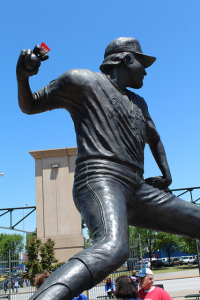
Ryan Doumit was brought in to be the power off the bench, and ostensibly a third catcher option that could allow manager Fredi Gonzalez to use Evan Gattis as a PH on his off days. He was useless as a catcher, and mostly useless as a RF. He was as mobile as the statues in Monument Alley and hit about as well.
Ramiro Pena posted an 80 wRC+, which is very good for a bench player. He plays multiple positions well, he’s switch-hitter, he can drop a bunt if needed, he’s a smart baserunner with decent speed, and he knows his role on the team. Unfortunately, he can’t hit a LHP to save his life. I like Pena, and I think he’s a valuable bench piece…probably the only one we had for most of the year.

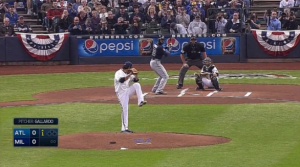

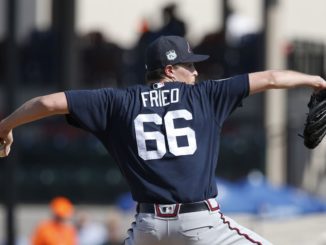

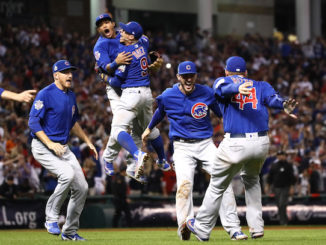
Very well-written but certainly don’t agree that Freeman or Heyward merits an “A” after their poor seasons. Both suffered several lengthy slumps that brought their final numbers far below expected levels. Nor is Simmons the team’s best defensive player; THAT honor belongs to Heyward, the best defensive player in the majors in 2014. I agree that Gattis had long and mysterious absences and that Simmons was a disappointment at the plate — especially since he was a batting champion in the minors. Maybe the 17 home runs last year went to his head. I also think you rated Justin too highly; despite his solid final numbers, he had long slumps, especially at the end, and fanned far too frequently, as did his brother.
~ “Very well-written…” ~
Thanks. I wonder sometimes if I am too verbose.
~ “…but certainly don’t agree that Freeman or Heyward merits an “A” after their poor seasons. Both suffered several lengthy slumps that brought their final numbers far below expected levels.” ~
Neither had a poor season. Both did have some periods of slumping, but every player has that.
You referenced Freddie having a Sid Bream-like season on Facebook, but that just isn’t true. Freddie’s counting numbers were certainly down from last year, but that isn’t because he was bad this year; he was the #5 offensive 1B in baseball, and 2nd behind Rizzo in the NL. Virtually all of his rates were relatively comparable to last season’s rates. His numbers were down from last year because last year was unsustainably high to due to some very favorable random variance in very specific situations (.505 BABIP with RISP).
Heyward started off slow, as he as done in every season since his arrival. And, like every season, he eventually found his stroke and became the catalyst for the offense. from May 15 through the end of the year, Heyward had a .771 OP (.290/.366/.405), with a 13% K-rate (well below average) and a 10% BB rate (well above average).
People make the mistake of looking at Heyward’s physique and think he should hit more HRs. But his skill set is that of a line drive spray hitter. Sure, he could alter his swing and try to hit more HRs, but doing things like that is what causes batters to get confused and start having seasons like Simmons did. Heyward hit 27 HRs a couple of years ago, but that was just as much a function of where he hit (3rd), who was on base in font of him (Bourn and Prado), and who was hitting behind him (Jones and McCann). Those factors were not present this year.
~ “Nor is Simmons the team’s best defensive player; THAT honor belongs to Heyward, the best defensive player in the majors in 2014.” ~
I think Simmons gets a nod there because he plays a much more difficult and important defensive position. That isn’t a slight to Heyward; I’m sure you know how I feel about him from the Facebook interactions (Editor Note: Dave and Chris are both members at Dave’s Facebook group: http://www.facebook.com/groups/BRAVESBANTER/ ). I just think that being the best SS in baseball outweighs being the best RF in baseball, in terms of defensive impact on the game. There isn’t a wrong answer here, IMO, and it is a GREAT sign for Braves fans that this is a point of contention.
~ “I agree that Gattis had long and mysterious absences and that Simmons was a disappointment at the plate — especially since he was a batting champion in the minors. Maybe the 17 home runs last year went to his head. I also think you rated Justin too highly; despite his solid final numbers, he had long slumps, especially at the end, and fanned far too frequently, as did his brother.” ~
I think Simmons just got caught up in trying to hit the long ball. That isn’t him, and he needs to get back to spraying the ball as a line drive hitter. Hopefully the new hitting coach can gt in his ear; Simmons is still young enough that giving him instruction and confidence can pay off.
I give Gattis some leeway in the time missed, because the kidney stones and strep were one of those “What the hell?” situations, similar to Heyward being beaned with a fastball or geting appendicitis, or Hudson getting his ankle shattered by a runner. But the back and muscle issues, and the earlier illness, are all things that are more relatd to durability, IMO.
Justin Upton ranked 7th of 27 qualified OF in the NL offensiely (133 wRC+). He was 2nd among qualified OF in HR. He was 2nd among qualified OF in RBI (although that is primarily a function of opportunity). He was 4th in SLG. He did strike out at a relatively high rate (26.7%), but his OBP and ISO were good enough to overlook the strikeouts. And, for comparison, Giancarlo Stanton struck out at virtually the same rate (27.6%).
Justin Upton a B-? I would have to think that is a bit low considering in a pitcher dominated season Upton finished in the top six in HR and RBI in the NL! I know his defense is not great but considering the pitching this season and very low power/slugging/RBI numbers he should be at least a B+ to A-.
Thanks for reading, Nick! One point, though…
Justin Upton received a grade of ‘A’ (it’s listed just after his name). The grade of ‘B-‘ applied to the outfield as a whole, since that outfield also consisted of a regular B.J. Upton, and backups Jordan Schafer, Ryan Doumit, and Emilio Bonifacio.
The pitcher grades will be posted tomorrow.